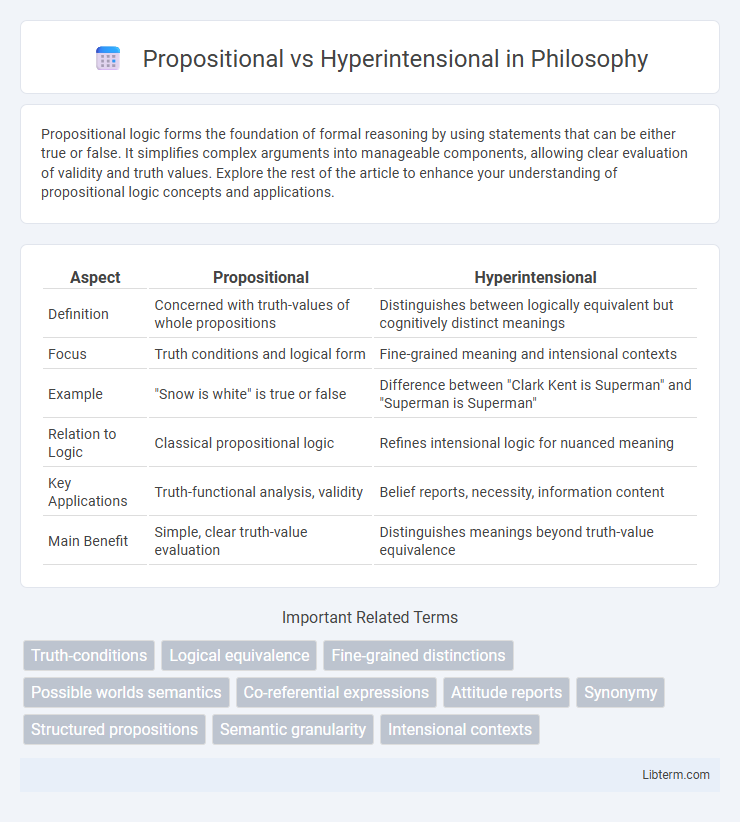Propositional logic forms the foundation of formal reasoning by using statements that can be either true or false. It simplifies complex arguments into manageable components, allowing clear evaluation of validity and truth values. Explore the rest of the article to enhance your understanding of propositional logic concepts and applications.
Table of Comparison
| Aspect | Propositional | Hyperintensional |
|---|---|---|
| Definition | Concerned with truth-values of whole propositions | Distinguishes between logically equivalent but cognitively distinct meanings |
| Focus | Truth conditions and logical form | Fine-grained meaning and intensional contexts |
| Example | "Snow is white" is true or false | Difference between "Clark Kent is Superman" and "Superman is Superman" |
| Relation to Logic | Classical propositional logic | Refines intensional logic for nuanced meaning |
| Key Applications | Truth-functional analysis, validity | Belief reports, necessity, information content |
| Main Benefit | Simple, clear truth-value evaluation | Distinguishes meanings beyond truth-value equivalence |
Introduction to Propositional and Hyperintensional Semantics
Propositional semantics analyzes meaning through truth conditions and the relationships between propositions in logical structures, emphasizing context-independent truth values. Hyperintensional semantics explores finer distinctions by focusing on the internal structure of propositions, capturing nuances that propositional semantics cannot differentiate, such as belief reports or modal contexts. This approach enables more precise modeling of semantic phenomena like intensionality and meaning variance beyond mere truth conditions.
Defining Propositional Content
Propositional content refers to the meaning expressed by a sentence that can be true or false, capturing the objective truth conditions of a statement. In contrast, hyperintensional contexts distinguish between propositions that are logically equivalent but differ in fine-grained meaning or cognitive significance. Defining propositional content emphasizes its role as an abstract, truth-apt entity, fundamental for semantics, logic, and communication analysis.
What is Hyperintensionality?
Hyperintensionality refers to the fine-grained distinction between expressions that share the same truth conditions but differ in cognitive or informational content, capturing distinctions beyond standard propositional logic. Unlike propositional contexts that treat equivalent statements as interchangeable, hyperintensional contexts preserve the differences in meaning, representation, or epistemic status of expressions. This concept is crucial in fields such as semantics, philosophy of language, and artificial intelligence, where precise modeling of informational content and belief states is necessary.
Key Differences Between Propositional and Hyperintensional Approaches
Propositional approaches analyze meaning based on truth conditions and logical equivalence, treating statements with the same truth value as interchangeable. Hyperintensional approaches distinguish between meanings more finely by examining the exact cognitive content or conceptual role, allowing differentiation between necessarily equivalent but conceptually distinct expressions. Key differences include the granularity of meaning representation and sensitivity to context, with hyperintensional frameworks capturing distinctions where propositional models collapse them due to equivalence in truth value.
Classic Examples Illustrating Propositional Semantics
Classic examples illustrating propositional semantics often involve the analysis of truth-conditional content, such as "Snow is white" being true if and only if snow is white. Propositional semantics focuses on the logical structure and truth values of statements, contrasting with hyperintensional contexts where fine-grained distinctions between expressions with the same truth conditions are crucial. The contrast between statements like "The morning star is the morning star" and "The morning star is the evening star" exemplifies classic propositional semantics emphasizing truth conditions rather than cognitive significance or belief contexts.
The Role of Hyperintensional Contexts
Hyperintensional contexts capture distinctions finer than those in propositional attitudes, allowing for differentiation between necessarily equivalent but intensionally distinct expressions. These contexts play a crucial role in logic and semantics by addressing identity problems where propositional intensionality fails, such as belief reports and modal statements. Understanding hyperintensionality enhances the analysis of meaning, reference, and mental state attributions in natural language and formal systems.
Advantages and Limitations of Propositional Semantics
Propositional semantics offers clear advantages in its straightforward representation of meaning through truth-functional components, making logical inference and computational processing efficient and scalable. It excels in handling consistent and objective truth conditions across diverse contexts but faces limitations in capturing fine-grained distinctions like intensionality and modality, which are essential in natural language understanding and epistemic contexts. Its reliance on propositional content often overlooks nuanced semantic differences, reducing its effectiveness in representing belief, knowledge, and intentional attitudes accurately.
Benefits and Challenges of Hyperintensional Analysis
Hyperintensional analysis offers precise distinctions between necessarily equivalent propositions, enabling fine-grained semantic representations crucial for contexts like belief reports and counterfactuals. Its benefits include improved accuracy in modeling meaning and intensionality, facilitating better handling of contexts involving attitude verbs and modality. Challenges involve increased complexity in formal systems and computational difficulty in implementation compared to traditional propositional approaches.
Applications in Philosophy, Linguistics, and Logic
Propositional and hyperintensional contexts differ in how they treat meaning and substitution of equivalents, with propositional contexts allowing substitution of logically equivalent statements, whereas hyperintensional contexts do not, emphasizing fine-grained distinctions in meaning. In philosophy, hyperintensionality is crucial for analyzing belief reports and knowledge attribution, avoiding the collapse of distinct cognitive states. Linguistics and logic use hyperintensional frameworks to model intensional verbs, context-sensitive semantics, and nuanced modal reasoning, enhancing precision in semantic interpretation and formal inference.
Future Directions in Semantic Theory
Future directions in semantic theory explore the integration of hyperintensional logics to address the limitations of propositional semantics in handling fine-grained distinctions of meaning, such as belief contexts and epistemic modality. Advances in formal frameworks aim to refine the expressive power of semantic models by capturing intensional nuances beyond propositional equivalence. Research also focuses on developing computational tools that implement hyperintensional semantics for improved natural language understanding and reasoning systems.
Propositional Infographic

 libterm.com
libterm.com